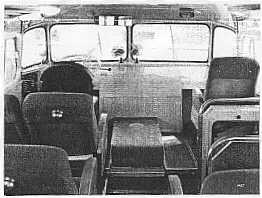

|
|
The late-model Super Duraliners built for export to Mexico were distinguished by rear exit doors. In the interior view, note the shift lever on the steering column and the minor obstacle presented by the forward engine--hardly noticeable!
------------------------------------------
needs little food or water--the Roadrunner is plenty fast to meet any need or schedule, is easy to manage, stops quickly and safely when there's danger ahead, and consumes less fuel--costing less to operate!"
The usual engine was the Cummins JBS-600 diesel, developing 150 hp and
mounted longitudinally in the rear. The old reliable Waukesha 140-GK was offered too, and
14 Roadrunners were sold as gas buses. Other engines used were P&H and GM diesels. Two
sizes of Roadrunners were in the catalog, a 33-passenger version with a 2O1-inch
wheelbase, of which onlya few were built, and the standard 37-passenger 237-inch
bus.
FitzJohn received a few orders for Roadrunners, but once again the Mexican distributor was the most active salesman. The last one built for an American carrier--which, oddly enough, was Florida Greyhound Lines (Greyhound had never pought more than a handful of FitzJohns but bought five Roadrunners for sightseeing work)--was delivered in 1957. A large Mexican order for 54 buses with Cummins diesels closed out the com- pany's production in May 1958.
Epilogue During the 31 years covered by the surviving sales records, FitzJohn constructed 2621 complete buses, 1460 bus bodies and 838 sedan stretchouts and trail~r conversion buses--plus, in the early years, a number of truck bodies. It is likely that in the years 1921 to 1927, for which we have no records, at least another 400 bus bodies were built, giving a total of more than 5300 vehicles. Through much of this history, in advertising and sales literature, the same slogan recurs: "If it's made by FitzJohn, it's made to make you money." FitzJohn's customers over the years were loyal to the maker until the economic facts of life in the postwar period forced them to change their minds.
Arrangements were made to continue Roadrunner production in Mexico. The Canadian plant was sold in 1959 to Bluebird Body Co. and used for the manufacture of school bus bodies; B.J. Hickey remained in charge of sales. What happened to the Muskegon plant is an open question. F.W. Feeney, longtime FitzJohn president, later became manager of Trailways' Bus & Car plant in Belgium, where he contributed his skill and experience to the development and production of the Silver Eagle. To him and to Mr. Herman D. Bolden of the Southern Coach Parts Co. go our sincere thanks for their en- thusiastic help in the preparation of this article.
20